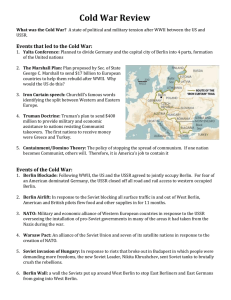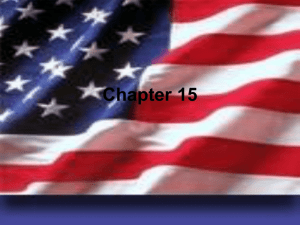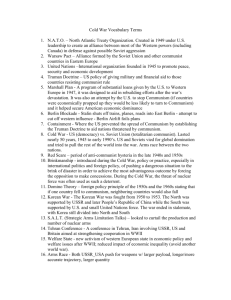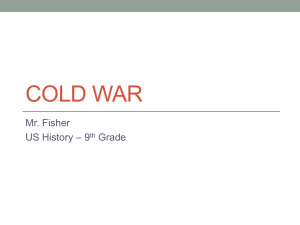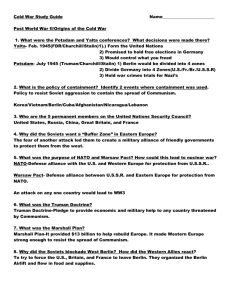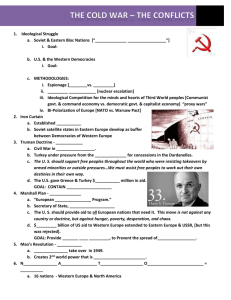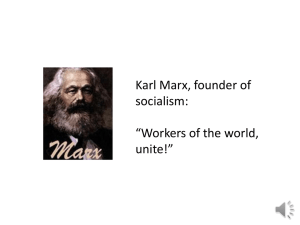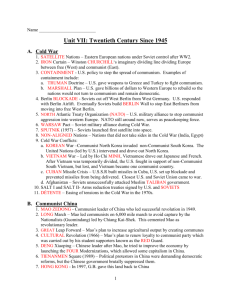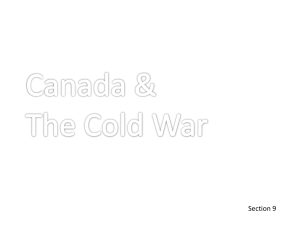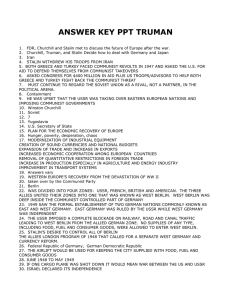The Cold War - mrsliftigsocialstudies
advertisement
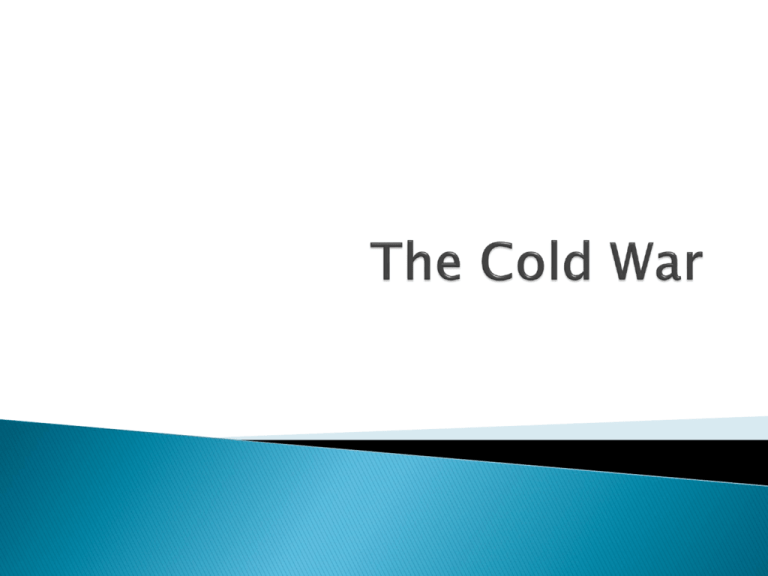
What do you know about the Cold War? List as many things as you can. Where did you learn or hear about this information? Review: What is Communism? Why does Communism conflict with democracy? If you need help, look back in your notes. What was the Cold War? Why did World War II cause a split between the United States and the Soviet Union? Conflict between the United States and the Soviet Union between 1945-1991 Why “cold”? Not fought like a typical war (battles) Struggle over different political ideologies Espionage (spying) Propaganda Multinational alliances Foreign aid to win allies Brinkmanship: Going to the “brink” (edge) of war Surrogate wars/proxy wars: Opposing powers use other countries as substitutes for fighting each other directly Three zones under military rule ◦ British, US, Russian Berlin in the Soviet zone Berlin divided into four zones: ◦ ◦ ◦ ◦ French (West Berlin) British (West Berlin) US (West Berlin) Soviet (East Berlin) Yalta Conference, 1945: Stalin promises free elections in Eastern Europe But wants Poland to be a barrier between the USSR and Germany (wants Poland Communist) By the Potsdam Conference: ◦ Separate “spheres of influence” ◦ Big 3 are no longer allies Founded in 1945 by 51 countries (now 192) General Assembly Security Council ◦ 5 permanent members US, China, Russia, Great Britain, France Veto powers ◦ 15 members total ◦ Goal to settle disputes and keep peace Look at the chart on pg. 532. Which US and Soviet aims in Europe conflicted? Our Essential Question today: What events occurred post-World War II that increased tensions between the USSR and US? Causes of the Cold War: Ideological/social Political Economic Is this an example of an American or Soviet escalation (“heating up”) of the Cold War? Is this a social/ideological, political, or economic cause? Or all three? What is a superpower? (there can be multiple answers for this…) What are some famous superpower countries from history? Who are the superpower countries today? Why? Yalta and Potsdam Soviet satellite nations Containment (1947) Truman Doctrine (1947) Marshall Plan (1947) Berlin Blockade and Airlift (1948-49) NATO and Warsaw Pact Iron Curtain (1946) Brinkmanship Based on your findings, who is more to blame—the US or the USSR? Explain. What is the event that had the greatest influence in causing the Cold War and why? Read and highlight. Questions: Why did Halvorsen (“Uncle Wiggly Wings”) drop candy for the children of Berlin? How do you think the candy bombings (Operation Little Vittles) influenced German attitudes towards the US following World War II? Read and highlight. Circle any words that are unfamiliar to you. Questions: What is the Soviet Union’s goal, according to Churchill? What does Churchill call for at the end of this excerpt? What recent event does he contrast with this? 1. What was the Iron Curtain? 2. What was the policy of containment? 3. Take a guess: What do you think the “domino theory” was? 1. Hint: What do dominoes do? What was the main goal of the US during the Cold War? If one country falls to Communism, neighboring countries will too… China becomes Communist! What were some of the problems with the Qing dynasty? Why did the Kuomintang rebel and establish a democracy? What did the Japanese do in China during World War II? Two leaders, two different ideologies: Nationalist Leader: Jiang Jieshi (or Chiang Kai-shek) Communist Leader: Mao Zedong Despite US support for Nationalists, Communists defeat them New government: People’s Republic of China ◦ Supported by USSR Nationalists set up their own government on the island of Taiwan ◦ Supported by US Communist China: Land given to peasants Collective farming and living ◦ All food goes to the government Propaganda: Cult of Mao Censorship, no political rights Key terms to look out for in the film: Collective farms/communes “The Great Leap Forward” (1958-1961) Red Guards The Cultural Revolution (1966-1968) What is one similarity you notice between the Communist countries we have learned about so far (Russia and China)? 1949: USSR gets the bomb 1952 and 1953: US and USSR create the Hbomb, more powerful than the A-bomb Brinkmanship 1957: Soviets create ICBM rocket (intercontinental ballistic missile) and launched Sputnik 1958: American satellite Explorer 1960: U-2 spy plane incident Step 1: Read the title, author, and intro. Step 2: Read the questions, especially the long answer question! Step 3: Highlight or underline: ◦ Main ideas ◦ Answers to the questions Carefully re-read the sections of the text when you answer the questions! Review: Today and tomorrow we will be learning about the Korean and Vietnam Wars. Make a prediction: with what we have learned about Eastern Europe and China, what do you think happens in these countries? Why do you think the US gets involved? 1950-1953 First “hot war” of the Cold War World War II: ◦ With Japanese surrender, Allies divide Korea at the 38th parallel (dividing the country) ◦ North: Soviet Union, communist ◦ South: United States, democratic Both sides wanted to reunify the country 1950: N. Korea invades S. Korea ◦ US, United Nations fights with the South ◦ China backs the North, sends 300,000 troops Result: Cease fire and stalemate at the 38th parallel Why might textbooks from different countries offer different versions of the same historical events? When textbooks offer conflicting accounts, how do you decide which textbook to believe? According to each textbook, how did the war start? Which textbook do you find more trustworthy? Why? Where else would you look to find out how the Korean War started? Which textbook comes from North Korea? Which comes from South Korea? Compare these textbooks with ours. Demilitarized zone Communist dictator Kim Il Sung and son Kim Jong Il Development of nuclear weapons 1. What did you think of the North Korea travel clips yesterday? 2. List the divided countries following World War II. 3. What are problems of divided countries? America’s longest war: 1950-1975 Millions of Vietnamese deaths and 58,000 American deaths Vietnam a French colony Ho Chi Minh: Communist revolutionary 1945: Beginning of fight for Vietnam’s independence Geneva Convention divided Vietnam along the 17th parallel S. Vietnam: ◦ Anti-communist Ngo Dinh Diem backed by US ◦ Corrupt dictatorship N. Vietnam: ◦ Communist Ho Chi Minh Northern plan to unify the country Revolt in the South: ◦ National Liberation Front (NLF) or the Vietcong ◦ Guerilla warfare ◦ Took control of the countryside Ho Chi Minh Trail: Armies from the North move South Gulf of Tonkin, 1965: ◦ Justification to go to war (Pres. Johnson) ◦ Stated that N. Vietnamese boats had attacked 2 US destroyers ◦ In fact, it is likely that no attack took place Obstacles to victory: ◦ Jungle fighting Tunnels Anti-war feeling at home Vietnamization: Giving more responsibility for the fighting to the Vietnamese Tet Offensive, 1968 My Lai US leaves the war in 1974; in 1975 S. Vietnamese gov’t. falls to N. Vietnam Khmer Rouge and Pol Pot in Cambodia ◦ Communist rebels ◦ Pol Pot murdered 2 million people Industrialized, capitalist nations: 1st world Communist nations: 2nd world Developing nations: 3rd world Asia, Africa, Latin America, Middle East “Nonaligned” ◦ Not with either side Cuba: ◦ Revolution ◦ Missile Crisis ◦ Bay of Pigs Nicaraguan Civil War Iranian Revolution Soviets in Afghanistan Imagine you’ve gotten into an argument with your best friend and now you are in a “cold war.” How could you “relax the tensions” between the two of you? French for “relaxation” Relaxation of tensions between the US and USSR in the 1970s Why? ◦ Duck and Cover Video Clip ◦ Arms Race Terms ◦ Discussion Question: What might have led to détente in the middle of the Cold War? What was an example of détente that you learned from yesterday’s presentations? What does evidence mean? What does analysis mean? Finally, take a look at your thesis statement. Is it arguable?
